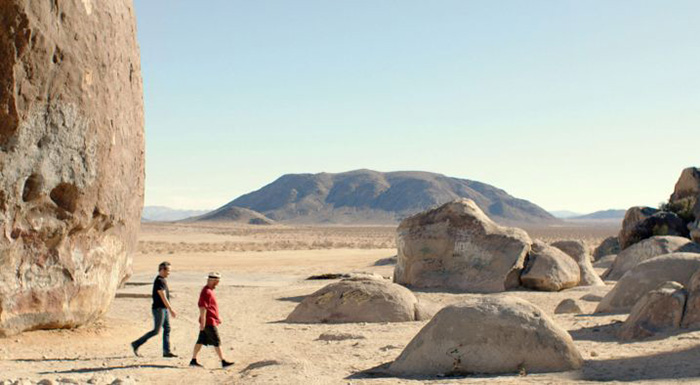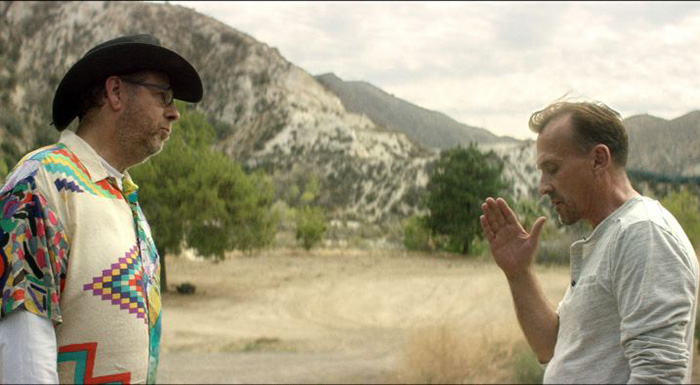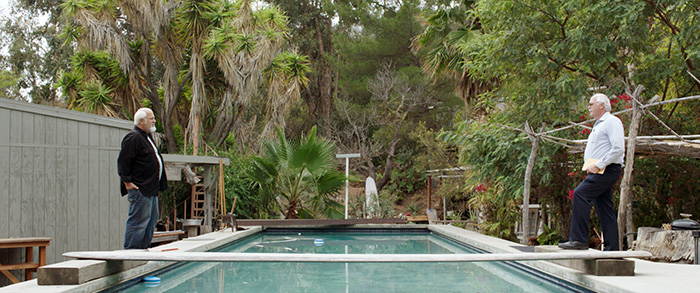It was around the time Pierre Bismuth won his Oscar as an original story creator on Eternal Sunshine of the Spotless Mind that he stumbled upon an unknown work by Edward Ruscha via a BBC documentary. This tape captured the artist as he created a fake rock dubbed “Rocky II,” a fiberglass/resin creation that ultimately replaced “Rocky I” once it was proven unsuitable for longevity in the desert (having been manufactured from wheat paste). It’s a fascinating discovery—a piece by a renowned figure that nobody’s seen or even knows exists because it’s missing from his resume of work. So, posing as a journalist in 2009 to enter a Ruscha retrospective, Bismuth confronts the pop artist with the titular question of his feature debut: Where Is Rocky II?
Ruscha admits its existence, bidding Bismuth “good luck” in finding it. So of course he drops everything to do exactly that. Talk about built-in Hollywood mystique, the simple fact it’s actually in the Mojave conjures countless hypotheses of why and how. Why has he kept it off the books? Is there nothing special about it besides the mysterious aura Bismuth’s stumbling rekindles? Or is the truth sinister? Maybe Ruscha hid something inside, a long forgotten clue holding the key to defrauding his entire career. Well, that last guess is probably a bit far-fetched, but you can’t deny the blockbuster appeal it instills. Screenwriters D.V. DeVincentis and Anthony Peckham sure couldn’t. They’re who bring its insanity to life on behest of Bismuth for an epic fictional race against time.

Wait. Isn’t this a documentary? How does a fictional short with Robert Knepper, Milo Ventimiglia, and Stephen Tobolowsky imagining a crazy plot of dead bodies and forgotten crimes do anything but sensationalize and remove focus from the real hunt at Bismuth’s movie’s core? The simple answer is nothing—it’s a laugh. The complicated answer concerns Where Is Rocky II? not caring about finding the rock. Instead this journey’s a glimpse at fantasy and art itself. Because what gives paintings or sculptures value? What designates one person as an artist of note while another gets dismissed as a talentless hack? Artistic worth is speculative. The rock pales in comparison to the stories it possesses both in its creation and potential to ignite a firestorm of interest forty years later.
The director calls this film “fake fiction” because while it uses documentary technique and is by his estimation 90% real, he shoots with fictional language. He lies—saying he just learned the photos he provided actual private investigator Michael Scott came from a BBC documentary despite having watched said tape a decade earlier—and always has cameras ready to capture that which shouldn’t be captured. He cuts to a glimpse of Scott from inside a house we’re to believe the detective stumbled upon himself (and he might have). But rather than resulting in spontaneous confrontations, Bismuth films his characters meeting for the first time within a pre-meditated, controlled way. It’s an odd feeling of artifice not because documentaries don’t utilize artifice, but because they never blatantly admit it.

Bismuth’s opening scenes with Scott are obviously planned. We watch him watering his lawn while the camera pans over numerous accolades and plaques adorning his office as the phone rings. These are expository shots leading to a bar to interview a prospective hire—a meeting that has no bearing on the Ruscha case. The only relevant moment in this whole sequence is Scott getting a call from Pierre. Bismuth is supplying fictionalized connections, telling a true story with the actual people involved as though it were scripted. Everything intentionally feels like a reenactment, but besides a few placement shots to situate his viewers the film is in fact fresh footage. Scott does use his skills to uncover leads and does bring us to the precipice of his goal.
We experience Scott’s frustrations and successes. We laugh as gallery owners and friends of Ruscha being interviewed smile and ask why he hasn’t just looked up Ed and asked him himself. Seeing Michael engage with faulty memories, misleading information, and the kindness of some who genuinely have the capacity to help point him in the right direction provides an invigorating adventure. We can see that those with no information are telling the truth and yet can’t help ourselves from investing in the unknowns as though a conspiracy is underway. This is human nature—we love to create something out of the ether to keep us moving forward. To find a rock in the desert is a futile endeavor, to decipher the puzzle of an intentionally obscured object exciting.

Bismuth juxtaposes Scott’s hunt with DeVincentis and Peckham’s brainstorm meetings to fulfill their mission of crafting a gun-toting thriller off the back of the actual case. These two fictionalize Scott into the ominous sounding “The Detective” and Ruscha into the enigmatic “Cal Joshua.” They seek to infuse eccentric characters and an explosive reveal to make the journey into more than life exposes. And yet these scenes are real life—they depict artists at work creating a story meant to appear realistic but not. They are manufacturing their own rock by taking an existing entity and fabricating it with the tools at their disposal. Suddenly a hunk of resin lost and without public meaning is as important as the Holy Grail. Fiction is filtered by fact and vice versa.
Soon Scott enlists artist and Ruscha friend Jim Ganzer to the pursuit (Bismuth disappearing to let his subjects run amok), their camaraderie a perfect parallel to DeVincentis and Peckham. The latter riffs about how far-fetched they can take the fiction while the former predict the rock’s true intentions. Conversations devolve into asides about baseball and extramarital affairs on one end, pill popping (courtesy of Mike White) on the other. What began as a straightforward narrative to find an artwork transforms into an epic three-pronged adventure spanning cinematic language while challenging creator/subject dichotomy. Art’s value comes from its ability to send your mind to the farthest emotional depths of your imagination. Ruscha’s rock might not have been conceived as art, but Bismuth ensures it’ll always be remembered as such.
Where Is Rocky II? screened at the Locarno Film Festival, presented by Art Basel.

